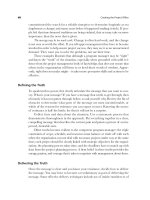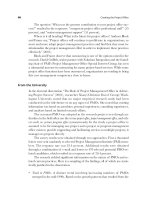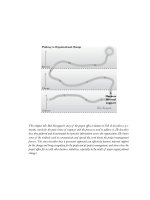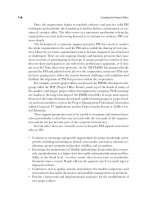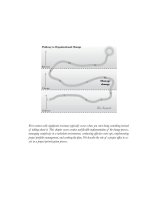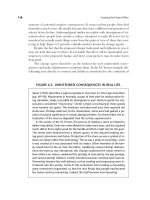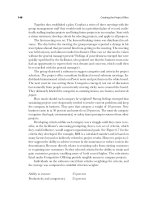Tài liệu Creating the project office 20 ppt
Bạn đang xem bản rút gọn của tài liệu. Xem và tải ngay bản đầy đủ của tài liệu tại đây (117.29 KB, 10 trang )
At the beginning of the project, Bucero—the assigned senior program man-
ager—ran a survey to determine how well HPC supported project management.
Sixty-five percent of the staff answered the survey. The results identified specific
areas where the project culture was weak:
• No holistic view of the project portfolio
• Lack of knowledge or access to reuse previous work
• No consistent approach for complex projects
• Lack of project culture
• No consistent PM skills
• Poor scope definition, validation, and management
• Bad risk identification
• Lack of sponsorship
• Project closing delays
The results indicated HP needed an effective infrastructure for people,
processes, and tools in the project office.
Mission and Objectives
People who have never worked on a project have difficulty understanding that, to
achieve project success, the organization must support the project manager. It took
almost six weeks to get an agreement with the management team about the rea-
son for this project.
168 Creating the Project Office
Establish sense of
urgency— clear danger
• establish infrastructure:
• people, processes,
and tools
• manage stakeholders
• evolve capabilities
and capacity
• review case studies
Leading
Organizational
Change
to PBO
Create guiding coalition—
powerful forces
Develop vision and
strategy—focus
Manage the change—
short-term wins, broad-based
action, consolidate gains
Develop broad-based action—
keep moving, implementing
Make change stick—
new PBO culture
The tale we tell
Communicate the change
vision—tell the tale
Staff and operate—
In or out?
The big question Bucero had to deal with was, “Why do we need a project of-
fice at all?” He explained to the management team that the project office adds
value to project team members by providing mentors, consultants, training, struc-
tured intellectual capital, and tools to be more effective. The project office also adds
value to HPC by providing culture shift to project management, reusable tools and
techniques, document and methodology support, global recognition, profitability
improvement, and quality support. And the project office adds value to customers
by providing visible signs of HP commitment, competent HP team support, and
quicker and more effective answers. The key to setting upper management sup-
port at this point was showing how the PMO solved current problems and pro-
vided immense business impact. A complete business case was presented to the
management team in the language and format of “management think.”
The business case presented tangible benefits that could be achieved in a short
time. The content of that presentation was to explain the PMO value to the or-
ganization, cost, flexibility and creativity obstacles, PMO functions, staffing, loca-
tion, virtual teams, and establishing the project office.
Bucero defended the value of a PMO to project team members, providing
mentoring and consulting services, training, tools to be more effective, a project
library, global recognition, profitability improvement, and organizational im-
provement and quality support.
Explaining the value to the organization, he described the benefits of the cul-
tural shift to project management, in terms of reusable tools and techniques, ad-
ministrative support, visible signs of management commitment, competent project
team support, and quicker and more effective answers to questions.
In terms of cost, he argued that although establishing and running a PMO
would not be cheap, it would be worthwhile because it would be no more expen-
sive than the cumulative cost of conducting project efforts without such an office,
and might well cost less in the long run. A major feature of a PMO would be a com-
prehensive approach to PM, and it would pay for itself very soon. The PMO would
help project managers feel they were not alone on the customer site. Somebody was
supporting them from the HP organization in a way that would make them feel
more comfortable not only to implement and execute projects but also to sell more.
The business case also included a role for the PMO to support creativity, re-
flecting a bias toward centralized decision making, and supporting team members
to be more effective. The PMO team would be there to help project managers
and project teams, not thwart their efforts to do the right thing. The first key suc-
cess factor is to support project managers.
In terms of services, he proposed to start with a Document Management Sys-
tem group (DMS) as a first priority, helping PMs and consultants to generate bids
faster and with higher quality.
Implementing the Project Office 169
Regarding PMO staff he proposed two alternatives:
• To serve in a simple support and facilitation role, the PMO would only need
three or four people.
• To play a central role in guiding an organization’s project efforts, the PMO
would need up to a dozen people.
He argued the approach selected would make a big difference to the kinds of
efforts the office would carry out.
One key factor considered was the visibility and accessibility of this group of
people. The PMO should be located where it made most sense, in this case inside
the existing department where it is accessible by all project managers and con-
sultants. The HPC Project Office belongs to the Business Operation group at HP
Consulting. They assigned a physical location for the office at the beginning of
the project and hung up a poster with the words “Project Office” above the phys-
ical space designated for the office. The advantages were that everybody could
see where the project office was located and identify where to go to request ser-
vices. Eventually the team members all added a PMO logo on their badges.
Project office members identified as a team and worked in that way.
He also included comments about their virtual world, arguing most projects
are in remote sites. The PMO, as the link between project managers and the rest
of the organization, greatly facilitates the reuse of libraries, methods, and stan-
dards. He told them establishing a PMO requires a lot of effort, and it demands
thorough and careful planning.
Finally he got management agreement about the mission and objectives for
this project. Some discussions were kept between the management team and him-
self to achieve this agreement because some people perceived the PMO was a bu-
reaucratic organism. He demonstrated there were more and more projects under
way; lack of knowledge about project management existed; and new people in
the organization had little experience in project management. Following the ap-
proach in Figure 7.1, the proposal was presented, studied, discussed and finally
accepted by the management team in February 2000. The PMO project started
on March 1 at the Madrid office.
Progress was aided by collecting data on current projects that encountered
extreme deviations and showing this information at management meetings. He
audited projects that suffered from lack of scope and risk planning, noting the cost
impact on the organization. He demonstrated that most projects had no formal
sponsor and explained that impact on the organization. Making a presentation to
the management team and setting clear expectations and deliverables at the be-
ginning were key to achieving the go-ahead decision.
170 Creating the Project Office
Because project managers were used to doing all the work themselves, in-
cluding documentation and project file archiving, and did not know that help was
available, a marketing campaign was necessary to communicate the existence of
the PO and sell its benefits to the whole organization.
Bucero announced the PO’s mission statement: To support HP Project Managers
during the project selling and delivery processes so they can focus on high-quality project man-
agement and added value. He followed up by describing its objectives as follows:
• Relieve HP consultants of standard activities (low added value)
• Provide quality assurance within the project delivery process
• Serve as a breeding ground for knowledge sharing, conducting project snapshots
• Be the home front for all PM initiatives
Scope
The project office was born to relieve consultants and project managers of some
administrative activities in the delivery of customer projects, helping them to focus
on project management activities. Project office duties include managing the
Implementing the Project Office 171
FIGURE 7.1. APPROACH TO PROPOSING AND IMPLEMENTING A PMO.
Conduct
assessment
Obtain
funding and
staffing
Conduct
pilot test
Roll
out
Determine
functions
and staffing
Identify
sponsor
Prepare
communications
plan
Prepare
plan and budget
project file—the documents to be authorized during the project life cycle—as well
as supporting proposal development, taking project meeting minutes, distributing
documentation, managing labor time registration, assuring invoicing schedule is
followed, and backing up the project manager.
After breaking down the first objective into smaller activities, one question
came to mind:
How did the end users feel about it?
The program manager had several meetings with consultants and project
managers to verify the initial scope. Figure 7.2 shows the different types of meet-
ings he conducted.
These meetings were extremely valuable. Getting these people involved from
the beginning was the only way to convince them to use the project office. Bucero
notes that being aligned with real user needs was his personal objective during the
whole project.
PMO Meetings
These meetings were conducted on a monthly basis and tremendously aided the
scope verification and management processes. “All the time invested preparing
172 Creating the Project Office
FIGURE 7.2. SCHEDULE OF MEETINGS.
Presenter
Management
Meetings
PMO lead
Duration
1 hour
Preparation
Effort
2 hours
preparing
strategy
and material
Material
Delivered
Objective
Slides
copy and
PMO
white
paper
Inform and
get upper
management
commitment
AttendeesMeeting
Type
Management
team
PM
Meetings
PMO lead
2 hours 4 hours
preparing
material and
examples
Slides
copy and
PMO
proposed
services
Share plans
and ideas
and ask for
feedback
Project
managers
Presales
Consultants
Meetings
PMO lead
and PMO
coordinator
1 hour 3 hours
preparing
material and
slides
Slides
copy and
presales
PMO
services
Share
information
and ask for
feedback and
validation
Senior
consultants
in presales
activities
